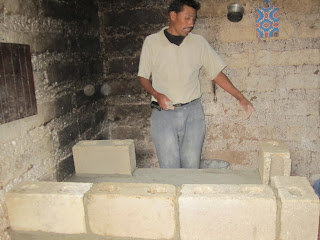In my time in Alta Verapaz I have spent a fair amount of
time working on developing an improved efficiency wood burning stove project. The cooperative where I work held a general assembly in September and
voted down participating, so I won't see these put in during my time here. It’s a disappointment in some ways, but it was the decision of the
community and that’s how things need to happen in participatory development.
I thought I'd still share what I've learned about the technology, since it is work that is being done by many other volunteers across Guatemala. Although its not a project I'll get done, it is certainly a relevant need for my community in A.V.
To set the scene, here are a few pictures of the current state of affairs
in kitchens in my community. Almost all houses use an open fire on a fire table, relying on the smoke making its way out between the space where the roof and walls do not meet. This leads to smoke in the living space, which leads to increased respiratory problems affecting women and children the most. What's more, it's a very inefficient use of fire wood, putting a squeeze on family budgets (either through money spent to purchase the wood or time spent to collect it) and exacerbating deforestation problems.
Now here is a set of photos of an improved wood burning
stove under construction. Most of these are from the trip that Wendy and I took to the department of San Marcos back in June to learn the construction process. This particular style of stove is unique to that community, and was designed
in collaboration with the participants/users to fit the cultural needs as an acceptable substitute for their previous set-up.
 |
The builders take a hoe to the hard packed dirt floor to get the base level
and measured out to the right dimensions. |
 |
| The base is three sides of a box built out of cinder block. |
 |
To prepare a concrete slab under the burning chamber, they built a frame
without nails so the wooden pieces could be easily removed and reused afterward. |
 |
| The finished form ready to pour the concrete. |
The slab has rebar in the middle to provide structure.
At this point the stove is left overnight to allow the concrete to set.
 |
| The next day, a third layer of block is placed upon the slab. |
 |
| The blocks are filled with pumice to increase the thermal retention. |
 |
| Bricks create an inner chamber, leaving another buffer of pumice between the blocks and bricks. |
 |
A pumice filling made the floor bricks ramp upwards toward the back of the stove.
This helps with air flow, and to prevent users from over-loading the stove with firewood. |
 |
| The cracks were filled... |
 |
| ...and the stove top checked for a perfect fit. |
 |
| The chimney is a cement tube for the first meter, then continues up as metal. |
 |
| The "hat" on the top of the chimney is a signature of every "improved stove." |
 |
| The exterior is coated and smoothed, although the stove top is left loose for easy removal during cleaning. |
 |
| A family posing by their completed stove. |
The final product has the four signature features of an improved stove: A metal stove top, a door where the fuel is inserted, a chimney, and a "hat" on the chimney top. In addition, this stove is has a larger work space along the top, since the stove is the main item in Guatemalan kitchens. This provides counter space for use in food preparation or for eating. The side left open below the fire chamber acts as an ideal space to store fire wood, particularly in rainy locations such as Alta Verapaz where it is a challenge to keep firewood dry.
Although these stoves won't be appearing in my community any time soon, I do still have hope that they will eventually be the standard kitchen ware here. I know that the process of developing the project captured the imaginations of many cooperative members, and that some of them may be just the leaders this community needs to get the project to fruition at some point in the future.






















Hi Bethany, from cousin Pat in case you don't recognize it. Some of this sounds pretty familiar......
ReplyDeleteMy question is, why did your community decide against these stoves?
Hey Pat,
ReplyDeleteAs is usually the case, it was a combination of reasons.
The cooperative wasn't willing to contribute funds to the project, but our outside funding source required %50 contribution (cash or in-kind contributions) from the community.
The committee wasn't willing to ask for the families destined to build stoves in their house contribute more than a very nominal sum.
The committee wasn't willing to adjust the goal, either through decreasing the number of stoves built or looking at different stove designs that might be more affordable (although less culturally functional).
Communication struggles and interpersonal conflict lead to a lack of trust and patience between a few key leaders and my site mate and myself.
I could go on.... suffice to say there were a lot of things contributing to it. I have all kinds of things I could have done differently, but I don't know if any of them would have made a difference to the outcome. As it is, I am happy I was able to stick to my guns on making sure it was THEIR project. If they couldn't do it the way they wanted to, I wasn't going to come in and force something to happen my way.